Documents: Go to download!
User Manual
- User Manual - (English)
- Energy Guide - (English)
- Connecting
- Using the Remote Control and Peripherals
- Internet Connection
- Troubleshooting Internet Connectivity Issues
- TV Viewing
- Picture and Sound Settings
- Troubleshooting
Table of contents
Owner Manual LED Monitor
Connecting
Antenna Connection
If you are not connecting your TV to a cable or satellite box, you must connect an antenna or a cable outlet to the TV to receive broadcast signals.
Connect a cable from an antenna or cable outlet to the ANT IN connector as shown in the diagram below.
Note: An antenna connection is not necessary when a cable box or satellite receiver is used.

Video Device Connections
Your TV has a variety of connectors for video input from external devices such as cable boxes, satellite receivers, Blu-ray players, DVD players, camcorders, and gaming consoles. Below is a list of featured connectors shown in descending order of picture quality.
- HDMI
- Component
- Composite (A/V)
Connect a video device to the TV via an HDMI connector for the best picture quality. If the device does not have an HDMI connector, try a component connector to get the next best picture quality.
Note: For the J5201 series model, the component port and composite (A/V) port are not be supported. Instead of this ports, you can use an HDMI port or an optical port on the TV to enable video or audio input of external devices.
Note: The number of connectors and their names and locations may vary depending on the model.
Note: Refer to the external device's operating manual when connecting it to the TV. The number of external device connectors and their names and locations may vary depending on the manufacturer.
HDMI Connection
The following types of HDMI cables are recommended:
- High-Speed HDMI Cable
- High-Speed HDMI Cable with Ethernet "
Note: Use an HDMI cable with a thickness of 0.55 inches (14mm) or less. "
Note: Using a non-certified HDMI cable may result in a blank screen or a connection error. " Some HDMI cables and devices may not be compatible with the TV due to different HDMI specifications. "
Note: This TV does not support HDMI Ethernet Channel. Ethernet is a LAN (Local Area Network) built with coaxial cables standardized by the IEEE.
Refer to the diagram and connect the HDMI cable to the video device's HDMI output connector and the TV's HDMI input connector.
Note: The number of connectors and their names and locations may vary depending on the model.

Once the connection has been made, press the SOURCE button to select the connected external device.
Component Connection
Refer to the diagram and connect the Component cable to the TV's component input connectors and the device's component output connectors.
Make sure the cable colors match the connector colors.
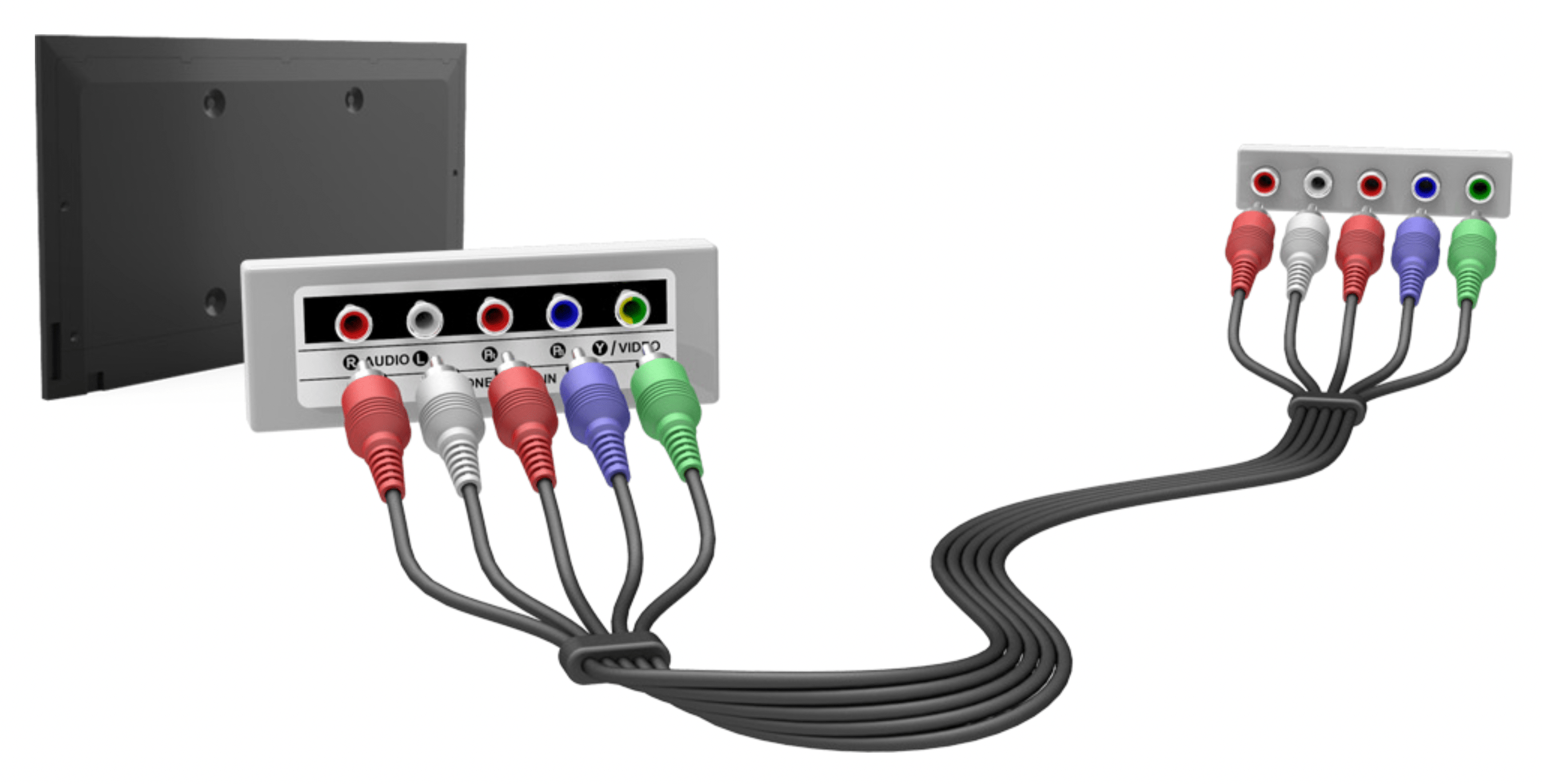
Once the connection has been made, press the SOURCE button to select the connected external device.
Composite (A/V) Connection
Refer to the diagram and connect the AV cable to the TV's AV input connectors and the device's AV output connectors.
If you are using the TV's AV input connectors, connect the device's audio output to the TV using a Y connector.

Once the connection has been made, press the SOURCE button to select the connected external device.
Audio Input and Output Connections
Your TV has a variety of connections for audio input from devices such as Blu-ray players and DVD players and for audio output to such devices as amplifiers. The connections are listed below.
- Digital Audio (Optical)
- Audio (Analog)
Note: For better audio quality, it is a good idea to use an AV receiver.
Note: The number of connectors and their names and locations may vary depending on the model.
Note: Refer to the external device's operating manual when connecting it to the TV. The number of external device connectors and their names and locations may vary depending on the manufacturer.
Note: When connecting the external device to the external speaker, be sure to connect the external speaker to the TV first, and then connect the external device. Sync problems may develop if the connection order is reversed.
Digital Audio (Optical) Connection
Connecting an AV receiver to the TV via a digital audio (optical) connector lets you listen to digital audio.
Note: Connecting a device using an optical cable does not automatically turn off the TV speakers. To turn off the TV's speakers, set TV Sound Output (Sound > Speaker Settings > TV Sound Output) to something other than TV Speaker.
Note: Adjust the audio device's volume using its remote control.
Note: An unusual noise coming from the audio device while you are using it may indicate a problem with the audio device itself. If this occurs, ask for assistance from the audio device's manufacturer.
Note: Digital audio is only available with 5.1-channel broadcasts.
Refer to the diagram and connect the optical cable to the TV's digital audio output connector and the device's digital audio input connector.

Audio Output Connection
Refer to the diagram and connect an audio cable to the TV's audio output connector and the device's audio input connector.
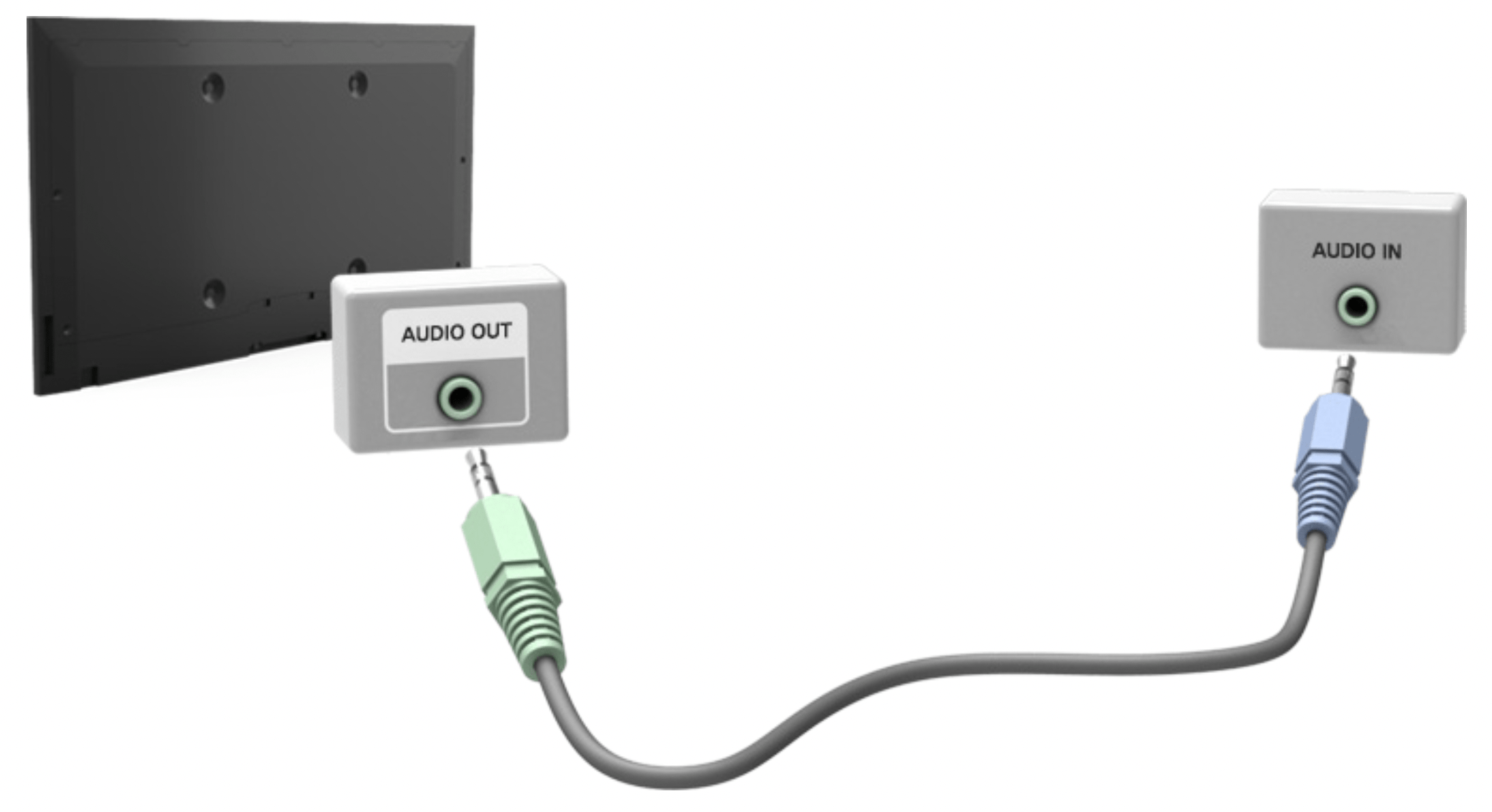
Connecting to a Computer
You can connect a computer directly to the TV using an HDMI or DVI to HDMI cable and use the TV as a monitor. You can also connect the TV to a computer via your home network and access media files saved on the computer on the TV screen. The kinds of connections you can make are listed below.
To use the TV as a Computer Monitor
- Connect through the HDMI Port using an HDMI cable.
You can connect the computer to the TV using an HDMI cable and display the computer screen on the TV. - Connect though the HDMI (DVI) port using a DVI to HDMI cable.
You can connect a computer to the TV by connecting the computer's DVI port to the TV's HDMI (DVI) port with a DVI to HDMI cable and display the computer screen on the TV.
To Access Media Files on a Computer and View or Play Them on the TV
- Connect Through Home Network.
Quickly access photo, video, and music files saved on a computer by connecting the TV and the computer to the same router or AP.
Using the Remote Control and Peripherals
Controlling the TV with a Keyboard
MENU > System > Device Manager > Keyboard Settings
Connecting a keyboard makes it easy to control most of the functions on the TV.
Note: Certain models do not support USB HID class keyboards.
Connecting a Keyboard
Connecting a USB Keyboard
Plug the keyboard cable into the TV's USB port. A connection message appears on the screen.
Using the Keyboard
Use the following remote features with the USB keyboard connected to the TV.
- Arrow Keys (moving the focus), Windows Key (MENU Button), Menu List Key (TOOLS Button), Enter Key (Select/run item), ESC (RETURN Button), Number Keys (Number Buttons)
- F1 (
 ), F2 (
), F2 (  ), F3 (
), F3 (  ), F4 (
), F4 (  ), F5 (SMART HUB), F6 (SOURCE Button), F7 (CH List), F8 (
), F5 (SMART HUB), F6 (SOURCE Button), F7 (CH List), F8 (  Button), F9/F10 (Volume Buttons), F11 / F12 (Channel Buttons)
Button), F9/F10 (Volume Buttons), F11 / F12 (Channel Buttons) - Page Up/Page Down: Scroll web browser pages up/down.
- Press and hold the Enter key: On the Smart Hub screen, navigate to an item and press and hold the Enter key to display the Options menu.
Changing Keyboards
Select System > Device Manager > Keyboard Settings > Select Keyboard. Designate which keyboard to use.
Note: Only one keyboard can be used at a time.
Input Languages, Keyboard Type, and Switch Language Key
Select System > Device Manager > Keyboard Settings > Keyboard Options. The following options are available:
- Keyboard Language
If the keyboard supports multiple languages, choose the language you want to use from the displayed list. - Keyboard Type
Match the Keyboard Type to the language selected in Keyboard Language.
See other models: NP530XBB-K08US 8.0", LS24D332HSX/ZA SM-W737AZSBATT LC49RG90SSNXZA
Note: The Keyboard Type list varies depending on which language was selected under Keyboard Language. - Switch Input Language
If the keyboard supports multiple languages, choose the key you want to use to switch between languages.
Controlling the TV with a Mouse
MENU > System > Device Manager > Mouse Settings
Connecting a mouse makes it easy to control most of the functions on the TV.
Note: Certain models do not support USB HID class mice.
Connecting a Mouse
Connecting a USB Mouse
Plug the mouse cable into the TV's USB port. A connection message appears on the screen.
Using the Mouse
Once a USB mouse is connected to the TV, a pointer appears on the TV's screen. You can use this pointer to control the TV in the same way you use a pointer on a computer.
- Selecting and Running an Item
Left-click using the mouse. - Showing Tools Buttons
Right-clicking displays the Tools buttons on the screen so that you can easily use the TV's functions.
Note: The Tools buttons may vary depending on the function your are using. - Scrolling the TV Menu or Screen
Move the mouse wheel up or down. This scrolls the TV menu or screen up/down. - Exiting the TV Menu or Feature
Click the X button. This closes the menu.
Note: The X button appears on the TV menu when a mouse is being used. Left-clicking once while using a feature displays the X button on the current screen.
Changing Mice
Select System > Device Manager > Mouse Settings > Select Mouse. Designate which mouse to use.
Note: Only one mouse can be used at a time.
Changing Mouse Buttons and Pointer Speed
Select System > Device Manager > Mouse Settings > Mouse Options. The following options are available:
- Primary Button
Choose which button (left or right) to use to select and run items. - Pointer Speed
Adjust the movement speed of the pointer that appears on the screen.
Internet Connection
Establishing a Wired Internet Connection
Connecting the TV to the Internet gives you access to online services and SMART features, and lets you update the TV's software quickly and easily through the Internet.
Using Cat 7 LAN Cables
We recommend using Cat 7 LAN cables to link your TV to the Internet Access Points.
Note: The TV will not be able to connect to the Internet if the network speed is below 10Mbps.
There are three ways to connect the TV to your Internet Access Points. Using Cat 7 cables, connect the TV to the Access Points as shown in one of the following illustrations.
- External Modem
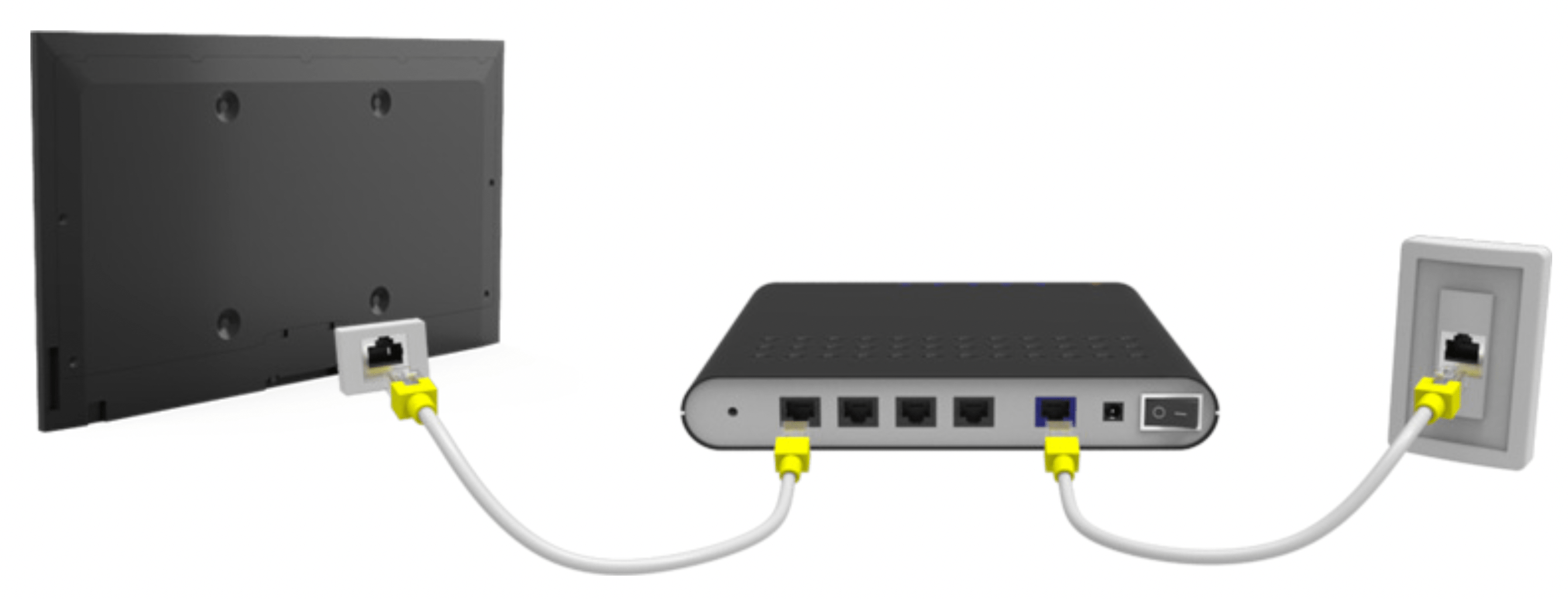
- ① IP Router + ② External Modem
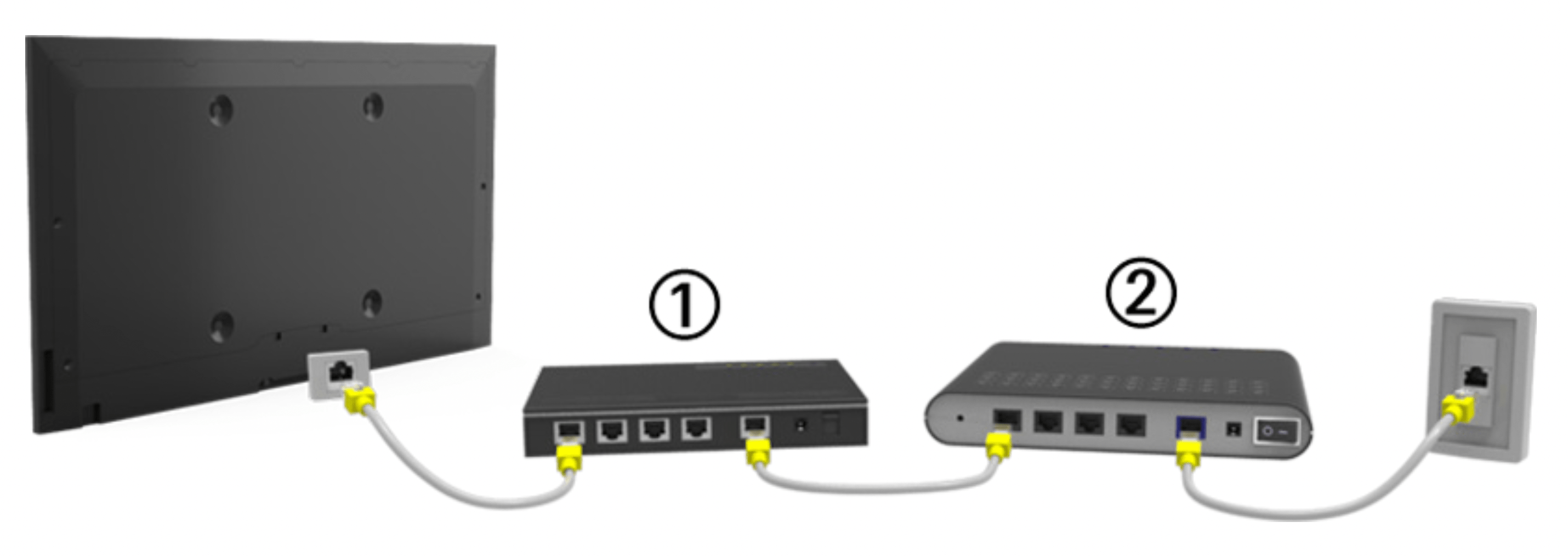
- Wall-mounted LAN Outlet

Connecting to a Wired Internet Network Automatically
MENU > Network > Network Settings
Automatically connect to an available network.
- Set the Network type to Wired, and then select Connect.
- The TV attempts to connect to an available network. Once it is successful, you will see a confirmation message. Select OK. If the attempt fails, try again, or connect manually.
Connecting to a Wired Internet Network Manually
MENU > Network > Network Settings
With networks that require a static IP address, you will need to enter the IP address, subnet mask, gateway, and DNS values manually to connect to the network. To get these values, contact your Internet Service Provider (ISP).
Note: Refer to the "Dynamic versus Static IP Addresses" section for more information on dynamic IP and static IP addresses.
- Set the Network type to Wired, and then select Connect.
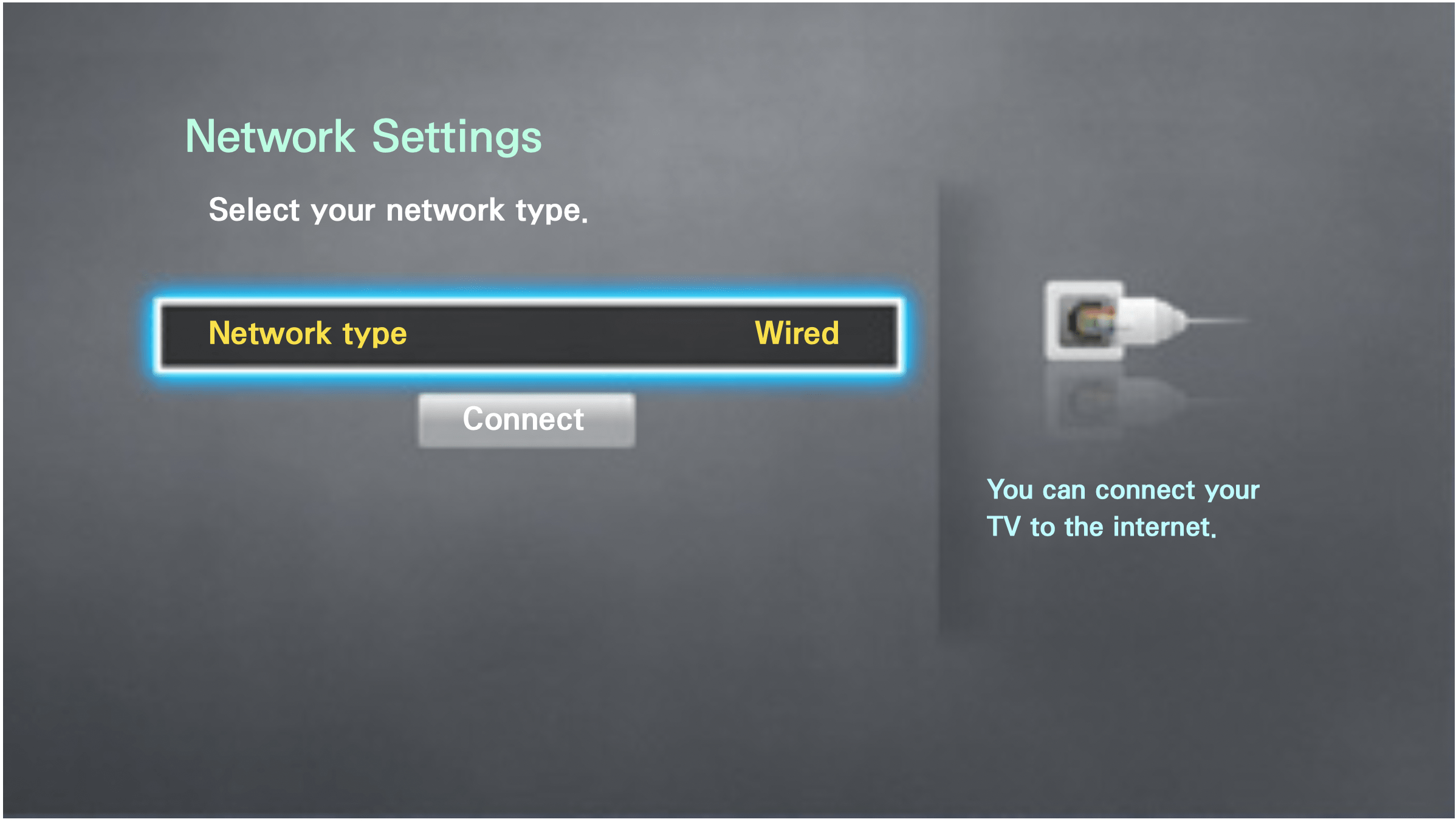
- Select Stop when the TV attempts to connect to the network. Once the network connection has been interrupted, select IP Settings.

- In the IP Settings screen, set IP Setting to Enter Manually.
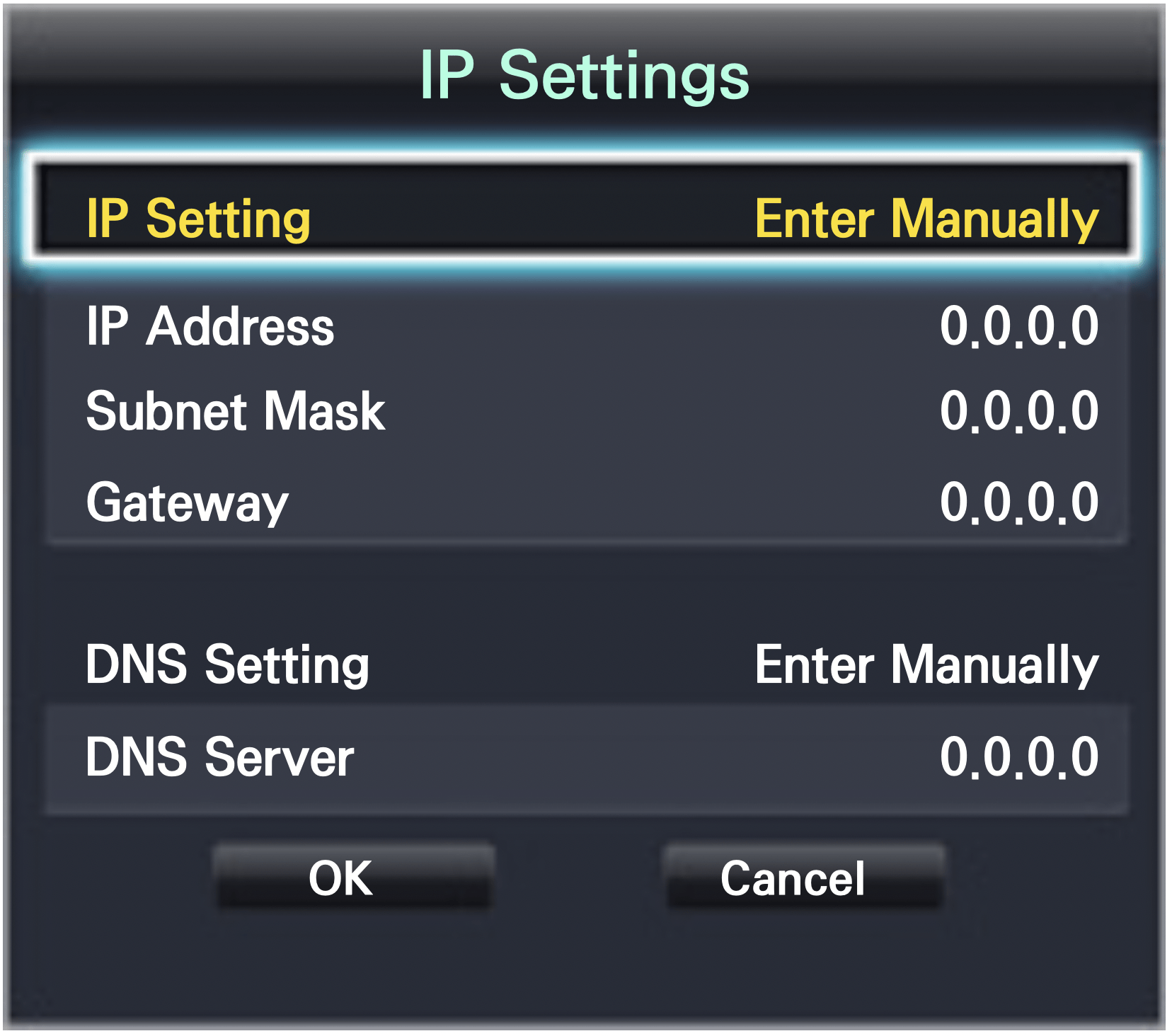
- Select IP Address. When the IP Address entry window appears, enter three digits into each field on the IP Address line. If the value has less than three digits, add leading zeroes. For example, to enter 10, enter 010. After three digits have been entered in a field, the highlight automatically jumps to the next field.
Note: Enter numbers by pressing the number buttons. After you have filled in all four fields, press the button again.
button again. - Repeat the process for Subnet Mask, Gateway, and DNS Server.
- When done, select OK.
- The TV attempts to connect to the network again using the settings you entered. Once it has established the connection, it displays a confirmation message. Select OK.
Note: The network connection speed may differ depending on the DNS server settings.
For details on the DNS server settings, contact your Internet service provider (ISP).
Establishing a Wireless Internet Connection
Connecting the TV to the Internet gives you access to online services and SMART features, and lets you update the TV's software quickly and easily through the Internet.

Connecting to a Wireless Internet Network Automatically
MENU > Network > Network Settings
Connect the TV to the Internet via a wireless router. Make sure you have the wireless router's SSID (name) and password settings before attempting to connect. The password can be found on the wireless router's configuration screen.
- On the Network Settings screen, set Network type to Wireless. The TV automatically displays a list of available wireless networks.
- Select a network. If the network you want doesn't appear in the list, select Add Network, and enter the network's SSID (name) manually.
- Using the on-screen keyboard that appears, enter the password. When finished, select Done. If the selected network is not security-enabled, the TV will by-pass the on-screen keyboard and attempt to connect right away.
To select a character on the on-screen keyboard, highlight the character and then select it. Select Caps to view capital letters. Select the 123#& key to view additional characters.
To view the password as you enter it, select Show Password. - The TV attempts to connect to the network. Once a connection is established, the TV displays a confirmation message. Select OK. If the attempt fails, try again or connect manually
Connecting to a Wireless Internet Network Manually
MENU > Network > Network Settings
With networks that require a static IP address, you will need to enter the IP address, subnet mask, gateway, and DNS values manually to connect to the network. To get the IP address, subnet mask, gateway and DNS values, contact your Internet Service Provider (ISP).
Note: Refer to the "Dynamic versus Static IP Addresses" section for more information on dynamic IP and static IP addresses.
- On the Network Settings screen, set Network type to Wireless. The TV automatically displays a list of available wireless networks.
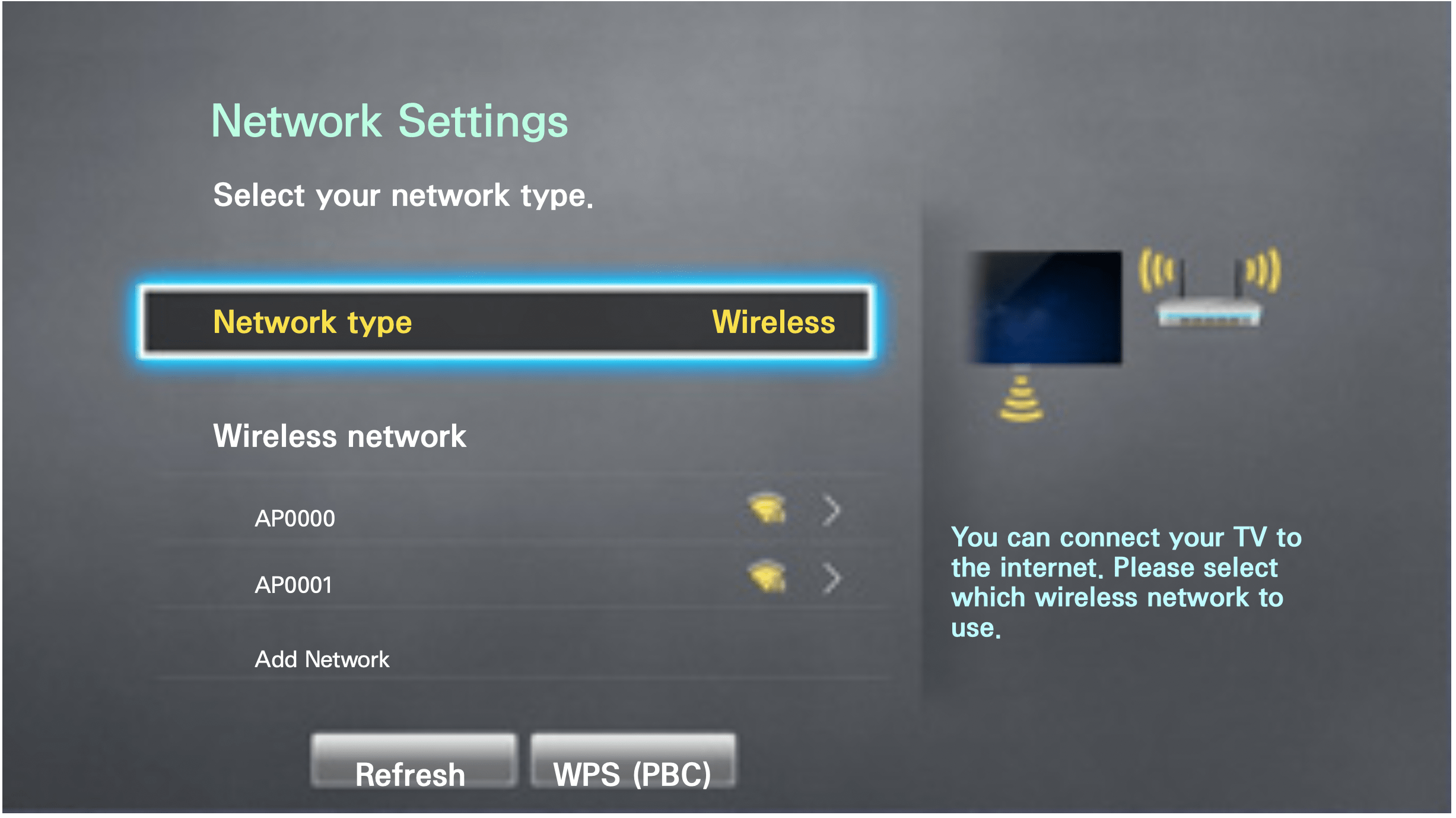
- Select a network. If the network you want doesn’t appear in the list, select Add Network, and enter the network’s SSID (name) manually.
- Using the on-screen keyboard that appears, enter the password. When finished, select Done. If the selected network is not security-enabled, the TV will by-pass the on-screen keyboard and attempt to connect right away.
To select a character on the on-screen keyboard, highlight the character and then select it. Select Caps to view capital letters. Select the 123#& key to view additional characters.
To view the security password as you enter it, select Show Password. - Select Stop when the TV attempts to connect to the network. Once the network connection has been interrupted, select IP Settings.
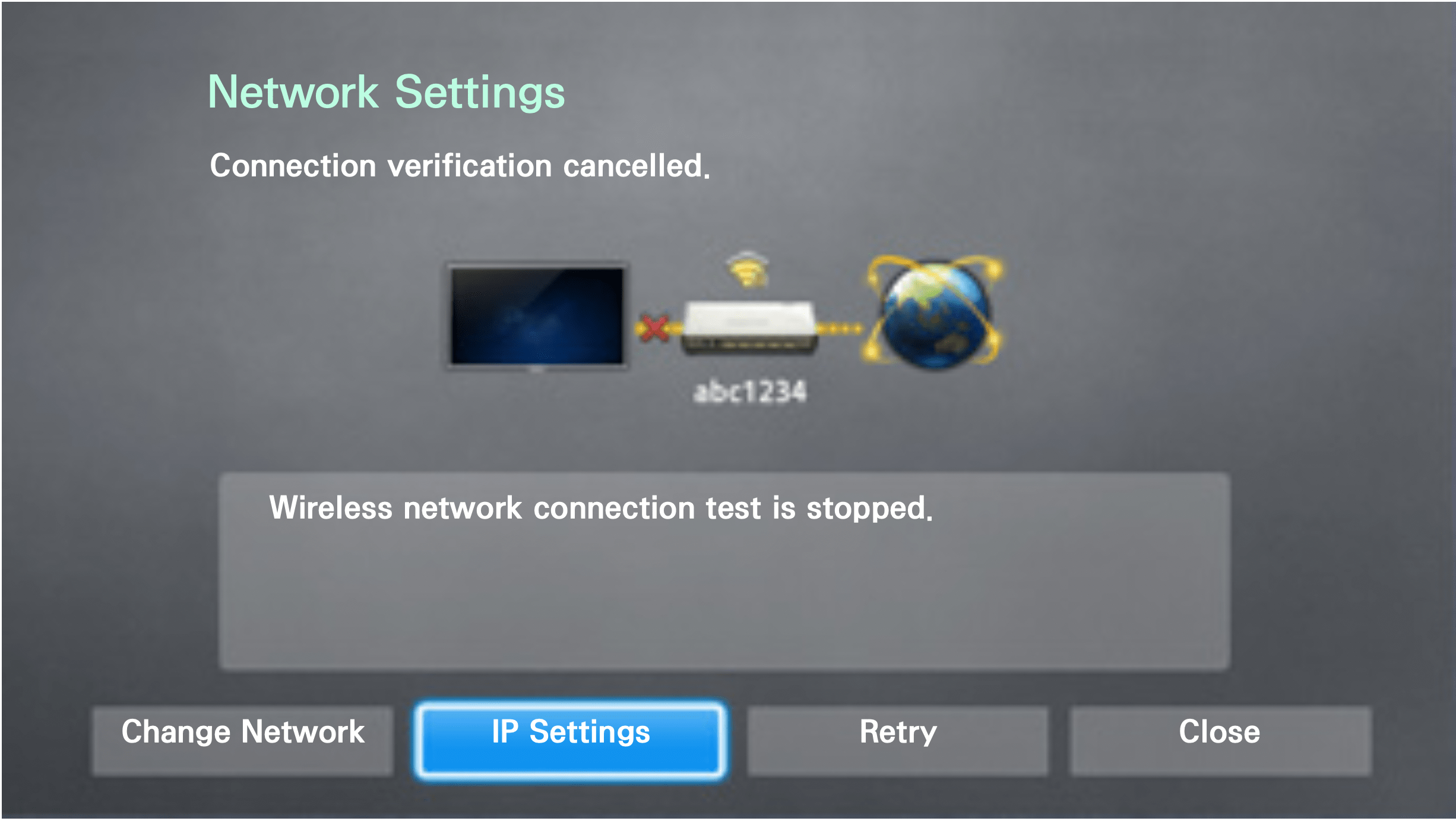
- In the IP Settings screen, set IP Setting to Enter Manually.
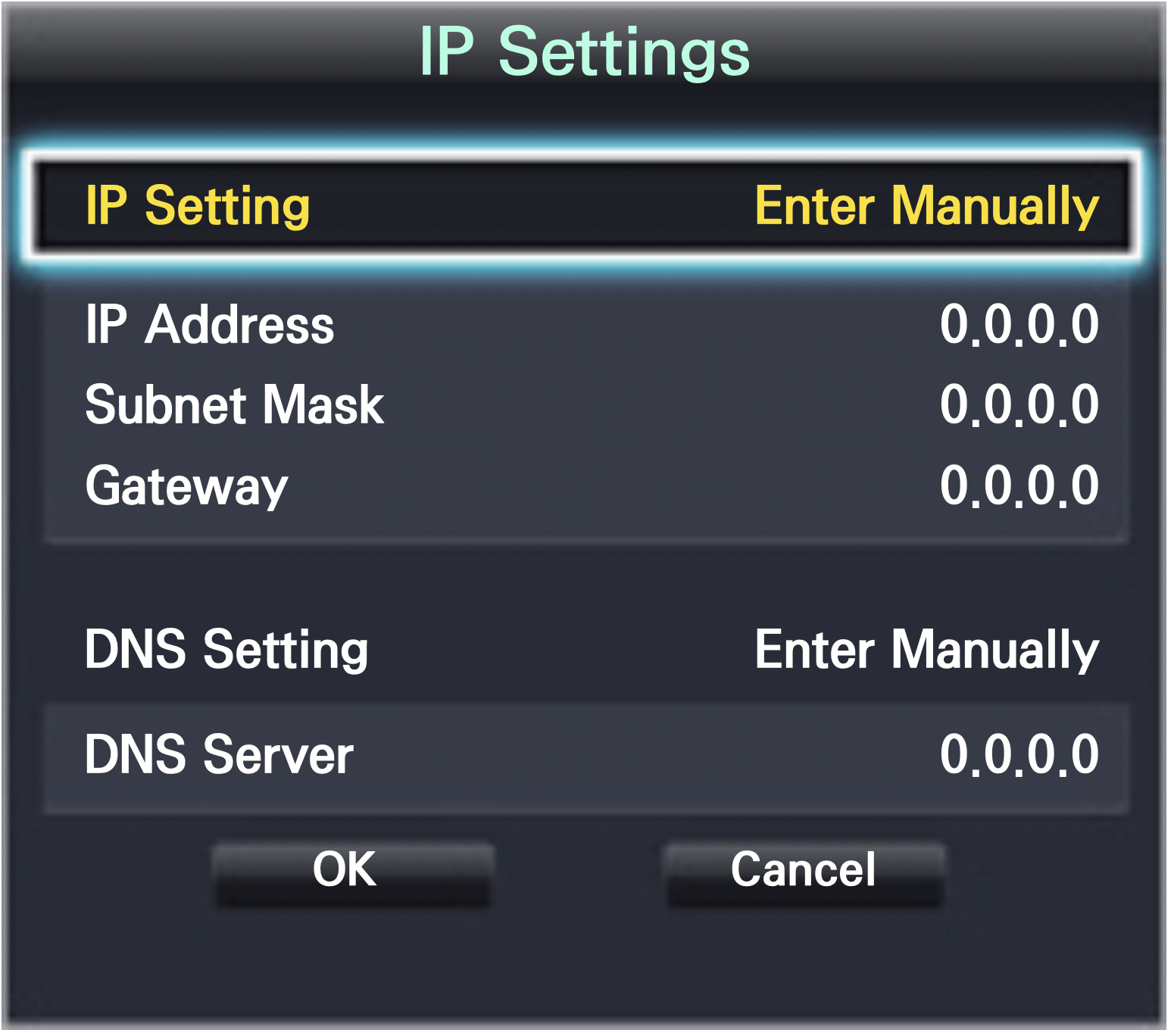
- Select IP Address. When the IP Address entry window appears, enter three digits into each field on the IP Address line. If the value has less than three digits, add leading zeroes. For example, to enter 10, enter 010. After three digits have been entered in a field, the highlight automatically jumps to the next field.
Note: Enter numbers by pressing the number buttons. After you have filled in all four fields, press the button again.
button again. - Repeat the process for Subnet Mask, Gateway, and DNS Server.
- When done, select OK.
- The TV attempts to connect to the network again using the entered settings. Once it has established the connection, it displays a confirmation message. Select OK.
Note: Network connection speeds may differ depending on the DNS server settings.
For details on the correct DNS server settings, contact your Internet service provider (ISP).
Connecting to a Wireless Internet Network with WPS
MENU > Network > Network Settings
If the router has a WPS push button, you can use it to connect the TV to the router automatically. WPS automatically configures the SSID and WPA key settings.
- Your router must support WPS to use the WPS functionality.
- On the Network Settings screen, set Network type to Wireless. The TV automatically displays a list of available wireless networks.
- Select WPS (PBC), and then press the router’s WPS or PBC button within two minutes.
- The TV automatically acquires the SSID and password settings, and then connects to the network. Once a connection is established, the TV displays a connection message. Select OK.
Troubleshooting Internet Connectivity Issues
If you are not able to connect the TV to the Internet, read the information below.
Troubleshooting Wired Internet Connectivity Issues
No network cable found
Make sure the network cable is plugged in. If it is connected, make sure the router is turned on. If it is on, try turning if off and on again.
IP auto setting failed
Do the following or configure the IP Settings manually.
- Ensure that the DHCP server is enabled on the router and reset the router.
- If this does not work, contact your Internet Service Provider for more information.
Unable to connect to the network
Do the following:
- Check all IP Settings.
- Ensure that the DHCP server is enabled on the router. Then, unplug the router and plug it back in.
- If this does not work, contact your Internet Service Provider for more information.
Connected to a local network, but not to the Internet
- Make sure that the Internet LAN cable is connected to the router's external LAN port.
- Check the DNS values in IP Settings.
- If the problem persists, contact your Internet Service Provider.
Network setup is complete, but unable to connect to the Internet
If the problem persists, contact your Internet Service Provider.
Troubleshooting Wireless Internet Connectivity Issues
Wireless network connection failed,
Selected wireless router not found. Go to Network Settings and select the correct router.
Unable to connect to a wireless router
Check the following:
- Check if the router is turned on. If it is, turn it off and on again.
- Enter the correct password if required.
IP auto setting failed
Do the following or configure the IP Settings manually.
- Make sure that the DHCP server is enabled on the router. Then, unplug the router and plug it back in.
- Enter the correct password if required.
- If this does not work, contact your Internet Service Provider for more information.
Unable to connect to the network
Do the following:
- Check all IP Settings.
- Enter the correct password if required.
- If this does not work, contact your Internet Service Provider for more information.
Connected to a local network, but not to the Internet
- Make sure that the Internet LAN cable is connected to the router's external LAN port.
- Check the DNS values in IP Settings.
- If the problem persists, contact your Internet Service Provider.
Network setup is complete, but unable to connect to the Internet
If the problem persists, contact your Internet Service Provider.
TV Viewing
Digital Broadcast Information at a Glance
MENU > Broadcasting > Guide
The Guide provides an overview of each digital channel's program lineup. You can check the program schedules and set up a Schedule Viewing.
Press the GUIDE button on the remote to launch the Guide.
Note: The information in the Guide is for digital channels only. Analog channels are not supported.
Using the Guide
To access the Guide functions, press and hold the E button. A popup window listing the following functions appears.
Channel Filter
Channel filter lets you filter the channels in the Guide by the following categories: Added Ch. and Favorites 1 - Favorites 5.
Navigating the Program Schedule
You can move the Guide by 2 hours in either direction each time you press the  or
or  button. You can only view programs scheduled after the current time.
button. You can only view programs scheduled after the current time.
Schedule Manager
This displays the schedule manager. For information about the Schedule Manager, see "Setting Up a Schedule Viewing".
Edit Favorite Channels
Edit favorites lets you designate a channel you have selected in the Guide as a favorite.
To use Edit Favorite Channels:
- Highlight a channel you want to add to your favorites in the Guide.
- Press the TOOLS button. The Guide functions pop-up window appears.
- Select Edit Favorite Channels. The Edit Favorites window appears.
- Select the Favorites list you want to put the channel into.
Viewing Detailed Information
You can view detailed information about a selected program. The program information may differ depending on the broadcast signal and may not be available at all for certain programs.
- Select a current program on another channel, and then View Details to Watch the program.
- Select an upcoming program, and then select View Details to set up a Schedule Viewing.
Note: For more information about watching or Schedule Viewing refer to "Setting Up a Schedule Viewing".
Checking Current Program Info
To get information about a show, press INFO on your remote.
Note: To view the program info, you must first set the TV's clock. Go to Clock (System > Time > Clock).
Note: The program information may vary depending on the type of incoming signal and may not be available at all for certain programs.
Use the  and
and  buttons to view information about upcoming programs. Select a program to set up a Schedule Viewing for that program.
buttons to view information about upcoming programs. Select a program to set up a Schedule Viewing for that program.
For more information on Schedule Viewing, refer to "Setting Up a Schedule Viewing".
Changing the broadcast signal
MENU > Broadcasting > Antenna
You can choose the appropriate DTV mode for your viewing environment. Choose Air or Cable. Air is suitable for homes equipped with a separate, over-the-air antenna. Cable is suitable for homes that have subscribed to a local cable-service or satellite-service provider.
Note: Do not use this function if your TV is connected to a cable or satellite box.
Digital Channel Signal Info and Strength
MENU > Support > Self Diagnosis > Signal Information
Select Support > Self Diagnosis > Signal Information. This displays the digital channel's signal information and strength.
Note: If your TV is attached to a separate, over-the-air antenna, you can use the signal strength information to adjust the antenna for increased signal strength and improved HD channel reception.
Note: Signal information is only available for digital channels.
TV-Viewing Support Features
Showing Captions
MENU > System > Accessibility > Caption
You can watch TV broadcasts with captions.
Note: Even if enabled, captions will not be displayed by programs that do not support captions.
Enabling Captions
Select System > Accessibility > Caption > Caption
Note: The TV cannot control or modify DVD or Blu-ray subtitles. To control DVD or Blu-ray subtitles, use the subtitle feature of the DVD or Blu-ray player and the player's remote control.
Selecting the Caption Language
Select System > Accessibility > Caption > Caption Mode to display a list of subtitle modes. The list of modes may vary depending on the broadcast.
- Default / CC1 ~ CC4 / Text1 ~ Text4
(Analog channels only) The analog caption function operates in either analog TV channel mode or when a signal is supplied from an external device to the TV. (Depending on the broadcast signal, the analog caption function may or may not work with digital channels.) - Default / Service1 ~ Service6 / CC1 ~ CC4 / Text1 ~ Text4
(Digital channels only) The digital caption function works with digital channels. Service1 Service6 may not be available in digital caption mode depending on the broadcast.
Changing the Font Color, Caption Size, and Font Opacity
Change the font color, background color, and size settings.
Select System > Accessibility > Caption > Digital Caption Options and then choose the setting to change.
- Size
Use to change the font size. Size is not supported by analog channels. - Font Style
Choose the font style for the subtitles. - Font Color
Use to change the font color. - Background Color
Use to change the caption's background color. - Window Color
Use to select the color of the digital caption window. - Font Opacity
Use to change the caption's opacity. - Background Opacity
Use to change the background's opacity. - Window Opacity
Use to select the transparency level of the digital caption window. - Edge Type
Use to select outline type of the digital captions. - Edge Color
Use to select the color outline of the digital captions. - Return to Default
This restores all caption display options to Default. Setting to Default applies the TV station's transmitted settings.
Note: The foreground and background color and opacity settings cannot be the same.
Enabling the Audio Guide for the Video Description
MENU > System > Accessibility > Video Description
Select System > Accessibility > Video Description. Activates the audio guide for the visually impaired. This function is only available with broadcasts that provide this service.
PIP Broadcast Viewing
MENU > Picture > PIP
Use the PIP ("Picture-In-Picture") function to watch TV in a small window within the main screen while also watching content from a DVD player, Blu-ray player, computer, or a different external device on the main screen.
Select Picture > PIP to display the PIP settings screen. The PIP settings screen contains the following options:
- PIP Setting
Activates/deactivates PIP. - Antenna
Choose Air or Cable as the digital channel mode. - Channel
Select the PIP sub-picture channel. - Size
Select the PIP sub-picture size. - Position
Select the PIP sub-picture position. - Select Sound
Select the audio source.
Choose a broadcast.
Note: You cannot use PIP while using Smart Hub function.
Note: Turning off the TV automatically disables PIP.
Note: Playing a game or using the karaoke feature on the main screen can result in lower PIP picture quality.
Note: For PIP to work, the main screen's source must be Component or HDMI and the input resolution must be less Full HD (FHD - 1080p). The PIP sub-screen supports digital channels only.
Scanning for Available Channels
MENU > Broadcasting > Auto Program
Automatically scans and indexes all channels received through the TV's antenna input connector.
Note: Do not use this function if your TV is connected to a cable or satellite box.
Note: If the TV has saved channels, Auto Program deletes the existing list, and then saves the newly scanned channels.
- Select Broadcasting > Auto Program.
- Select Start when prompted. This initiates the Auto Program function. The process can take up to 30 minutes to complete.
Selecting the Broadcast Audio Language
MENU > Broadcasting > Audio Options
Configure the program's audio language. Audio Options functions differently for analog and digital channels.
Note: Press the INFO button to view the current broadcast's audio signal information.
Selecting the Broadcast Audio Language (Digital)
- Selecting a Language
Select Audio Options > Preferred Language, and then choose a language. Digital broadcasts contain audio signals in multiple languages. Digital programs that include the language you selected in Preferred Language are automatically played using that language. If the language you selected is not supported by the broadcast signal, the TV will use the default audio language broadcast by the TV station.
Selecting the Broadcast Audio Language (Analog)
- Listening to Multi-Track Sound
Select Audio Options > Multi-Track Sound. Configure the audio for the current broadcast. MultiTrack Sound can be set to mono or stereo, depending on the broadcast signal or program. However, this option is automatically set to mono if the broadcast signal or program does not support stereo.
Note: Press the INFO button to view the current broadcast's audio signal information.
Note: While watching TV, press the TOOLS button, and then select Multi-Track Sound.
Fine-Tuning the Screen
MENU > Broadcasting > Channel Settings > Fine Tune
Note: Available for analog broadcasts only.
Analog pictures can become shaky and full of noise. If this happens, you can fine-tune the signal and/or reduce noise to clear up the picture.
- Select Broadcasting > Channel Settings > Fine Tune. An adjustment bar appears on the screen.
- Press the
 or
or  button to make adjustments. Select Save or Close to apply the new setting. Select Reset to reset the Fine-Tune operation.
button to make adjustments. Select Save or Close to apply the new setting. Select Reset to reset the Fine-Tune operation.
Remove Scrambled Channels
MENU > Broadcasting > Channel Settings > Clear Scrambled Channel
Remove scrambled channels from your auto-programed channel list.
Picture and Sound Settings
Picture Support Functions
Changing the Picture Size and Position
Choosing the Right Screen Size
MENU > Picture > Picture Size > Picture Size
Most TV programs and videos are displayed in full screen, but some programs and videos are displayed in sizes that are larger or smaller. You can change the screen size for such programs and videos so that the picture fits the screen better.
Note: Supported screen sizes vary depending on the input signal. Refer to the "Picture Sizes and Input Signals" section for more information about supported screen sizes.
- 16:9
Set the picture to the 16:9 wide-screen format. - Zoom1
Magnify 16:9 pictures vertically. A magnified picture can be moved up and down. - Zoom2
Magnify Zoom1 picture even more. A magnified picture can be moved up and down. - Wide Fit
Enlarge the aspect ratio of the picture so it fits the entire screen. Enjoy 4:3 images as undistorted 16:9 images. - 4:3
Sets the picture to basic 4:3 mode. - Screen Fit
Displays the full image without any cutoff. - Custom
Magnifies or shrinks 16:9 pictures vertically and/or horizontally. A magnified or shrunk picture can be moved left, right, up, and down.
Adjusting the Screen Position
MENU > Picture > Picture Size > Position
Adjusts the screen position.
Note: This option is only available with Size set to Zoom1, Zoom2, Wide Fit, or Screen Fit. When the TV is tuned to a digital channel, the screen position cannot be adjusted if the Picture Size is set to Screen Fit.
- To adjust the screen's position, select Picture > Picture Size > Position. A popup window appears.
- Select Position again from the popup window.
- Press the
 ,
, ,
,  or
or button to move the screen. When done, select Position and then Close. Select Reset to reset the screen position.
button to move the screen. When done, select Position and then Close. Select Reset to reset the screen position.
Listening to Audio Only with the Screen Turned Off (Picture Off)
MENU > Picture > Picture Off
Turns off the screen and plays audio through the speakers only. To turn the screen back on, press any button other than the power and volume buttons.
Resetting the Picture Mode Settings
MENU > Picture > Reset Picture
Use this option to reset the current Picture Mode to its factory settings. This does not affect the settings of other Picture Modes.
Sound Support Functions
Selecting Speakers
MENU > Sound > Speaker Settings > TV Sound Output
TV Sound Output lets you choose which speakers the TV uses for audio output. Select Sound > Speaker Settings > TV Sound Output, and then select the speakers from the list. To listen to audio through the TV's speakers and the speakers of a connected AV receiver or home theater simultaneously, select TV Speaker. If this causes an echo effect, choose any speaker option other than TV Speaker to mute the TV speakers, or turn off the receiver or home theater.
Note: Using external speakers alone disables the volume button and the mute function. In addition, certain Sound options are also disabled.
- TV Speaker
Listen to the TV's audio through the TV's internal speakers. - Audio Out
Listen to the TV's audio though headphones or through the speakers of a device connected to the TV via a digital optical cable. - Receiver
Listen to the TV's audio through the speakers of a home theater or receiver connected to the TV via HDMI.
Note: This function is not available on certain models in specific geographical areas.
Designating the TV's Installation Type
MENU > Sound > Speaker Settings > TV Installation Type
Specify the TV's installation type. Choose between Wall Mount and Stand to optimize the TV's sound automatically.
Enabling Digital Audio Output
MENU > Sound > Additional Settings
This Smart TV is SPDIF-enabled. The Sony Philips Digital Interface (SPDIF) provides digital audio output to speakers and various digital devices, including A/V Receivers and home theaters.
- Audio Format
Selects the Digital Audio output (SPDIF) format. The available Digital Audio output (SPDIF) formats may vary depending on the input source. - Audio Delay
This setting helps correct timing mismatches between the audio and video tracks when you are watching TV and listening to audio through a digital audio device. Enabling the feature displays a slide bar that you can use to adjust the delay by up to 250ms. - Dolby Digital Comp
Set Dolby Digital compression mode. - Auto Volume
When you change channels, video sources, or content, Auto Volume automatically adjusts the TV's volume level so that the volume level remains the same for all sources. For example, if you switch from a streaming video application to a Blu-ray player or a favorite TV channel, Auto Volume can modify the volume up to 12db to equalize the sound.
The Auto Volume function has two settings: Normal and Night. Normal applies a normal level of volume adjustment. Night applies a slightly lower volume level and is ideal for late-night TV viewing. If you want to use the volume control of a connected source device to control the sound, deactivate the Auto Volume function. When you use the Auto Volume function with a source device, the device's volume control may not function properly.
Resetting All Sound Settings
MENU > Sound > Reset Sound
Use to reset all sound settings to the factory defaults.
Troubleshooting
The TV has several built-in systems designed for user and TV system support.
Support through Remote Management
MENU > Support > Remote Management
If you need assistance with your TV, you can use this feature to let Samsung Electronics diagnose your TV remotely. You will need to read and agree to the service agreement before using this feature. A Samsung Electronics technician will then diagnose, repair, and update your TV remotely. These features are only available when your TV is connected to the Internet.
Getting Remote Support
Samsung Remote Support service offers you one-on-one support with a Samsung Technician who can remotely.
- Diagnose your TV
- Adjust the TV settings for you
- Reset your TV to its factory settings.
- Install recommended firmware updates
How Does it Work?
Having a Samsung Tech service your TV remotely is easy.
- Call the Samsung Contact Center and ask for remote support.

- Open the menu on your TV and go to the Support section.

- Select Remote Management, and then read and agree to the service agreements. When the PIN screen appears, provide the PIN number to the agent.

- The agent accesses your TV.

Finding the Information You Need for Service
MENU > Support > Contact Samsung
Use this option to display the address of the Samsung website, the call center phone number, your TV's model number, your TV's software version, the Smart Hub info, and other information you may need to get service support from a Samsung call agent or the Samsung website.
Requesting support
MENU > Support > Request Support
Note: Usability depends on your specific model and local region.
When you are using the Smart TV during difficulties, you can request service support.
Note: It is only available when connected to the internet. After checking the network connection status, request service support.
- Navigate to Support > Request Support. A pop-up window appears.
- Select Agree. A Request Support screen appears.
Note: It is only available when you agree to the Terms and Conditions. - Write your Name and Phone Number.
- After selecting the category of the problem, select Send.
Note: You can select up to 3 categories. " If an error occurred, retry the request after confirming your Name, Phone Number and Problem. If you leave an entry blank, or write incorrect information, the support request may fail.
There is a problem with the picture
Testing the Picture
MENU > Support > Self Diagnosis > Picture Test
Before you review the list of problems and solutions below, use Picture Test to determine if the problem is caused by the TV. The Picture Test displays a high definition picture you can examine for flaws or faults. If the test picture does not appear or there is noise or distortion, the TV may have a problem. Contact Samsung’s Call Center for assistance. If the test picture is displayed properly, there may be a problem with an external device. Please check the connections. If the problem persists, check the signal strength or refer to the external device’s user manual.
| The Problem | Try this! |
|---|---|
|
Flickering and Dimming |
If your Samsung Television is flickering or dimming sporadically, you may need to disable some of the energy efficiency features. Disable Energy Saving (System > Eco Solution > Energy Saving) or Eco Sensor (System > Eco Solution > Eco Sensor). |
|
Component Connections/Screen Color |
If the color on your Samsung television screen is not correct or the black and white colors are off, run Picture Test (Support > SelfDiagnosis > Picture Test). If the test results indicate that the problem is not caused by the TV, do the following:
|
|
Screen Brightness |
If the colors on your Samsung TV are correct but just a little too dark or bright, try adjusting the following settings first.
|
|
Ghosting, Blurring, or Juddering |
If you notice ghosting or blurring on the screen, use the LED Clear Motion option (Picture > Picture Options > LED Clear Motion) to resolve the issue. |
|
Unwanted Powering Off |
If your Samsung TV appears to turn off by itself, try disabling some of the TV's energy efficiency features. See if Sleep Timer (System >Time > Sleep Timer) has been enabled. The Sleep Timer automatically turns the TV off after a specified period of time. If the Sleep Timerhas not been enabled, see if No Signal Power Off (System > Eco Solution > No Signal Power Off) or Auto Power Off (System > Eco Solution > Auto Power Off) has been enabled and disable them. |
|
Problems Powering On |
When the TV is turned on, the remote control receiver flashes 5 times before the screen turns on. If you are having problems powering on your Samsung television, there are a number of things to check before calling the service department. Confirm that the TV's power cord is connected correctly at both ends and that the remote control is operating normally. Make sure that the antenna cable or cable TV cable is firmly connected. If you have a cable/satellite box confirm that it is plugged in and turnedon. |
|
Unable to find a Channel |
If your TV is not connected to a cable box or satellite box, run Setup (System > Setup) or Auto Program (Broadcasting > Auto Program). |
|
The TV image does not look as good as it did in the store. |
Store displays are all tuned to digital, HD (high definition) channels. If you have an analog cable/set top box, upgrade to a digital set top box. Use HDMI or Component cables to deliver HD (high definition) picture quality. Many HD channels are upscaled from SD (Standard Definition) content. Look for a channel that is broadcasting true HD content.
Adjust the cable/satellite box's video output resolution to 1080i or 720p. |
|
The picture is distorted. |
The compression of video content may cause picture distortions, especially in fast moving pictures from sports programs and action movies. A weak or bad quality signal can cause picture distortions. This is not an issue with the TV. Mobile phones used close to the TV (within 3.2 ft) may cause noise in analog and digital channels. |
|
The color is wrong or missing. |
If you’re using a Component connection, make sure that the Component cables are connected to the correct jacks. Incorrect or loose connections may cause color problems or a blank screen. |
|
The color is poor or the picture is not bright enough. |
Go to the Picture menu and then adjust the Picture Mode, Brightness, Sharpness, and Color settings. See if Energy Saving (System > Eco Solution > Energy Saving) has been enabled. Try resetting the picture. (Picture > Picture Reset) |
|
There is a dotted line on the edge of the screen. |
If the Picture Size has been set to Screen Fit, change the setting to 16:9. Change the cable/satellite box resolution. |
|
The picture is black and white. |
If you are using AV composite input, connect the video cable (yellow) to the TV's green component jack. |
I can't hear the sound clearly
Testing the Sound
MENU > Support > Self Diagnosis > Sound Test
Before you review the list of problems and solutions below, make sure that the TV Sound Output menu item is set to TV Speaker, and then listen to the speakers again. If the TV still does not play audio, run the Sound Test. The Sound Test uses a built-in melody to check for sound problems. If the TV does not play sound during the Sound Test, or the sound is distorted, there may be a problem with the TV. Contact Samsung’s Call Center for assistance. If the TV plays the Sound Test melody without distortion, there may be a problem with an external device. Please check the connections. If the problem persists, refer to the external device’s user manual.
| The Problem | Try this! |
|---|---|
|
There is no sound or the sound is too low at maximum volume. |
Check the volume control of the device (cable/satellite box, DVD, Blu-ray, etc.) connected to your TV. |
|
The picture is good but there is no sound. |
Set Sound > Speaker Settings > TV Sound Output to TV Speaker. If you are using an external device, check the device’s audio output option. (For example, you may need to change your cable box’s audio option to HDMI if the box connected to your TV is using an HDMI cable.) To listen to the computer sound, connect the external speaker to the computer’ s audio output connector. If your TV has a headphone jack, make sure there is nothing plugged into it. Reboot the connected device by disconnecting and then reconnecting the device’s power cable. |
|
The speakers are making an odd sound. |
Make sure that the audio cable is connected to the correct audio output connector on the external device. For antenna or cable connections, check the signal information. A low signal level may cause sound distortions. Run Sound Test (Support > Self Diagnosis > Sound Test). |
There is a problem with the broadcast.
| The Problem | Try this! |
|---|---|
|
The TV is not receiving all channels. |
If your TV is not connected to a cable box or satellite box:
|
|
There are no captions with digital channels. |
Go to Caption (System > Accessibility > Caption) and change the Caption Mode. Some channels may not have caption data. |
|
The picture is distorted. |
The compression of the video content may cause picture distortions. This is especially true with fast moving pictures from sports programs and action movies. A weak signal can cause picture distortions. This is not a problem with the TV. |
My computer won't connect.
| The Problem | Try this! |
|---|---|
|
The "Mode Not Supported" message appears. |
Set your PC’s output resolution so it matches a resolution supported by the TV. |
|
The video is OK but there is no audio. |
If you are using an HDMI connection, check the audio output setting on your PC. If you are using a DVI to HDMI cable, a separate audio cable is required. |
I can't connect to the Internet.
| The Problem | Try this! |
|---|---|
|
The wireless network connection failed. |
Confirm your wireless modem/router is on and connected to the Internet. Reset your wireless modem/router by turning it off, waiting for 15 seconds, and then turning it on again. Run Network Setup (MENU > Network > Network Settings). |
|
The software update over the Internet has failed. |
Check the network connection status (MENU > Network > Network Status). If the TV is not connected to a network, connect to a network. The upgrade stops if you already have the latest software version. |
I am having trouble launching/using apps.
| The Problem | Try this! |
|---|---|
|
I launched an app, but it's in English. How can I change the language? |
Languages supported by the app may be different from the user interface language. The ability to change the language depends on the service provider. |
|
My application is not working. |
Check with the service provider. Refer to the help section on the application service provider's website. |
My file won't play.
| The Problem | Try this! |
|---|---|
|
Some files can't be played. |
This problem may occur with high-bitrate files. Most files can be played back, but you might experience problems with high-bitrate files. |
I want to reset the TV.
| Reset | Path | Description |
|---|---|---|
|
Reset Settings |
MENU > Support > Self Diagnosis > Reset |
Reset Picture, Sound, Channel, Smart Hub, and all other settings, except for the network settings, default settings. |
|
Resetting Smart Hub |
MENU > Smart Hub > Smart Hub Reset |
Resets all Smart Hub settings to their factory defaults and deletes all information related to Samsung accounts, linked service accounts, Smart Hub service agreements, and Smart Hub applications. |
Other Issues
| The Problem | Try this! |
|---|---|
|
The TV is hot. |
Watching TV for an extended period of time causes the panel to generate heat. The heat from the panel is dissipated through internal vents running along the top of the TV. The bottom, however, may feel hot to the touch after extended use. Children watching TV need constant adult supervision to prevent them from touching the TV. This heat, however, is not a defect and does not affect the TV's functionality. |
|
The picture won’t display in full screen. |
HD channels will have black bars on either side of the screen when displaying up scaled SD (4:3) content. Black bars will appear at the top and bottom of the screen when you watch movies that have aspect ratios different from your TV. Adjust the picture size options on your external device or set the TV to full screen. |
|
The "Mode Not Supported" message appears. |
The output resolution of the attached device is not supported by the TV. Check the TV's supported resolutions and adjust the external device’s output resolution accordingly. |
|
The Captions item in the TV menu is grayed out. |
You cannot select the Caption menu if you have selected a source connected to the TV via HDMI or Component. To view captions, turn on the external device's caption function. |
|
The TV smells of plastic. |
This smell is normal and will dissipate over time. |
|
The Signal Information option under Self Diagnosis isn't activated. |
Verify that the current channel is a digital channel. The Signal Information is only available for digital channels. |
|
The TV is tilted to the side. |
Remove the base stand from the TV and reassemble it. |
|
The Broadcasting option has been deactivated. |
Broadcasting is only available when the Source is set to TV. The Broadcasting menu cannot be accessed while you watch TV using a cable box or satellite receiver. |
|
The settings are lost after 5 minutes or every time the TV is turned off. |
If the Use Mode is set to Store Demo, the TV's audio and video settings are automatically reset every 5 minutes. Change the Use Mode (Support > Use Mode) to Home Use. |
|
There is an intermittent loss of audio or video. |
Check the cable connections and reconnect them. Loss of audio or video can be caused by using overly rigid or thick cables. Make sure the cables are flexible enough for long term use. If you are mounting the TV to a wall, we recommend using cables with 90-degree connectors. |
|
There are small particles on the TV's bezel. |
This is part of the product’s design and is not a defect. |
|
The PIP menu is not available. |
PIP functionality is only available when you are viewing video from an HDMI or Component source on the main screen. |
|
A POP (TV’s internal banner ad) appears on the screen. |
Change the Use Mode (Support > Use Mode) to Home Use. |
|
The TV is making a popping noise. |
The expansion and contraction of the TV's outer casing may cause a popping noise. This does not indicate a product malfunction. The TV is safe to use. |
|
The TV is making a humming noise. |
Your TV utilizes high-speed switching circuits and high levels of electrical current. Depending on the TV's brightness level, the TV may seem slightly noisier than a conventional TV. Your TV has undergone strict quality control procedures that meet our demanding performance and reliability requirements. Some noise coming from the TV is considered normal and is not an acceptable cause for an exchange or refund. |
